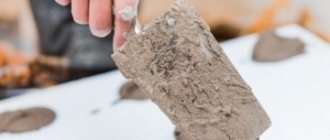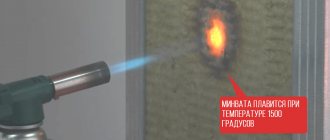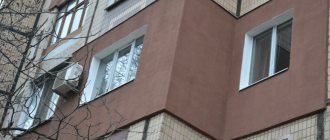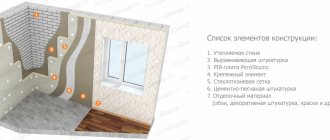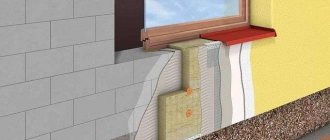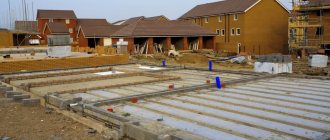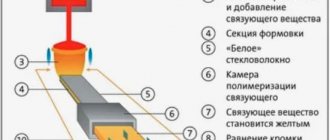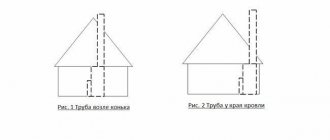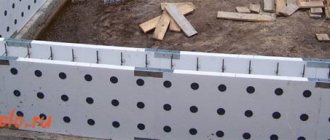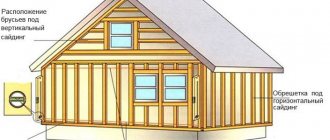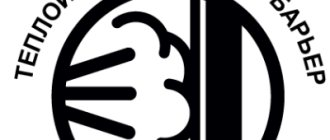Advantages of external insulation
If you insulate a house, including a wooden one, from the inside, the dew point shifts. Thanks to this indicator, the required temperature level is determined. If the temperature is below the required level, condensation will form. The dew point in this case will be located inside the building. As a result, humidity will increase, the walls of the room will “sweat” and various molds will appear.
In addition, if you carry out interior decoration of the building, this visually reduces the space. Another negative factor of internal insulation is the general deterioration of the indoor climate. If the house is insulated from the inside, the wood will not be able to “breathe,” and this also negatively affects its properties.
Insulating a wooden house with Penoplex eliminates all these negative aspects.
Advantages
If you place a thermal insulation layer inside the house, the dew point will shift. This indicator determines the temperature value below which condensation occurs. In this case, the dew point moves indoors. This means that the humidity will increase, the walls will begin to “sweat” and mold will form. Internal insulation reduces the space of the room.
Even a small thickness of insulation can significantly reduce the square footage, because to thermally insulate a wooden building you will need to install sheathing. Another factor is the deterioration of the internal microclimate. The use of even modern thermal insulation materials will not allow wood to “breathe”. Insulation from the outside eliminates all of the above factors.
Is it possible to insulate a wooden house with EPPS?
Wall insulation with Penoplex is allowed only in frame houses.
Insulating a wooden house with Penoplex is not always possible. First of all, you need to look at the design of the house itself. For example, if it is a frame, then polymer materials can be used to insulate any structural elements. If we are talking about structures made of logs or timber, then insulating a wooden house from the inside with Penoplex can still be allowed, but external insulation of walls in this case is simply excluded.
Such limitations are associated with the characteristics of extruded polystyrene foam. It practically does not allow steam to pass through, the coefficient is only 0.013 mg/m*h*Pa. For ordinary foam plastic, this value is five times higher, not to mention natural wood, which transmits steam in a volume of 0.32 mg/m*h*Pa.
The use of extruded polystyrene foam will disrupt the natural circulation of air, and the house will stop breathing.
As a result:
- moisture accumulates in the wood structure;
- harmful microflora is actively developing;
- the wood fibers are destroyed and the material rots.
Insulating a wooden house from the inside with Penoplex means installing thermal insulation in the floor and attic floor, on the roof, but not on the walls. At the same time, you need to understand that we are talking about the theoretical possibility of using extruded polystyrene foam. The material is very expensive and therefore it is mainly used only for insulating the foundation or basement. This type of work can be attributed to the insulation of a wooden house from the outside with Penoplex, since the foundation and base are also structural elements of housing.
Eps and wood
Extruded polystyrene foam has a separate “relationship” with wooden walls.
If you want wooden walls to “breathe”, then this option will require another insulation for the walls of the house outside under the siding. Penoplex simply prevents water vapor from escaping - the wooden wall will rot, and as a result, the walls of the house will become unusable.
To prevent this from happening, the wooden walls on the interior side are lined with vapor barrier - a film that does not allow water vapor to pass through, leaving it in the room.
In this case, water vapor does not enter the wall and, as a result, there is nothing to condense between the wall and the layer of vapor-tight insulation.
For the same reason, it is possible to use EPS as insulation in a frame house, because the inside of the frame is covered with a vapor barrier with overlap and taping of the seams.
However, in this situation there are two important additions for a wooden house:
- Since wooden walls now do not allow water vapor to pass through, proper exhaust ventilation must be organized to remove this vapor from the interior to the street.
- By installing a vapor barrier from the inside on wooden walls, you actually turn your home into a “thermos”. Are you sure this is what you want?
As for timber, timber is also wood. I think that after reading this section, you yourself can now tell us how to properly insulate a house made of timber from the outside with penoplex under the siding.
What is the best insulation for siding?
There is no need to mention all the insulation materials. Let's look at the materials that are asked about more often. The choice is between polystyrene foam and mineral wool.
What is polystyrene foam?
This is foamed polystyrene that does not absorb water. It cannot be combined with timber - the dew point (condensation) will be between the insulation and the wood. The moisture has nowhere to go. This will cause mold to appear. The fungus will shorten the life of the wood, it will become difficult to breathe in the house, and a musty smell of dampness will appear. Penoplex - hard foam plastic, lasts 50 years, suitable for:
- for insulation of brick foundations, under plaster;
- for insulating floors that are poured with concrete;
- for the ceiling, under filling with sand, sawdust, clay.
Mineral wool remains
Why choose this insulation? It is difficult to find a replacement that matches the price and quality. The material has a number of advantages over other products:
- by heat capacity;
- hygroscopicity;
- wide range of temperatures at which it retains its properties;
- fire resistance;
- ease of installation;
- large assortment;
- reasonable price.
Basalt wool is suitable for external insulation of a house made of timber. When purchasing, pay attention to the manufacturer. Give preference to European ones, such as Ursa, Paroc, Isover, Rockwool. If you choose the right density and do not violate the installation technology, these materials will last 40 - 50 years.
Basaltine differs from mineral wool, which contains the binding element formaldehyde 2.5 - 10% and components: slag, charge, lime, clay, etc. It consists of volcanic fiber diabase and gabbro. It surpasses its analogues in quality and durability.
This is an environmentally friendly product. Moisture getting inside does not saturate the fibers, but curls up into droplets that erode. Therefore, the properties of the material are preserved. Compare the characteristics of insulation from different manufacturers and make an informed choice. Buy a quality product so you don’t have to redo the job in 10 to 15 years.
A little theory
Regardless of the material of the walls, in the house, the external enclosing structures that provide the heat transfer resistance required by the standards are subject to drafts, and in the absence of proper ventilation, mold forms, fungus affects the walls and ceilings.
In the case of a wooden house, the walls of which “breathe” - releasing water vapor through the natural pores of the wood - improper insulation without ventilation will lead to the formation of mold. In order to prevent such a disaster from happening, the insulation design must freely release steam, which means that each subsequent layer in the direction of the street must have greater vapor permeability.
For wood, this figure is 0.06 mg/(m*h*Pa), for penoplex – 0.018 mg/m*h*Pa. That is, when insulating the outside of a house with penoplex, water vapor will settle on the surface of the wooden wall, which will gradually lead to its rotting. This disaster can be avoided by laying a vapor-permeable film and an air gap between the insulation and the wall.
This solution will allow steam to be removed outside, condensate to accumulate on the vapor barrier, and then ventilated through the air gap. Since penoplex has minimal water absorption (from 1 to 4%, depending on the brand), water vapor coming from the house will not significantly affect its thermal conductivity, and low vapor permeability will not allow water vapor from the atmosphere to penetrate to the wooden wall.
IMPORTANT: Insulating an external wooden wall with penoplex from the inside due to the low vapor permeability of the material will require the creation of a forced ventilation system, since the steam will not have access to the outside.
Characteristics of penoplex
This is the name given to extruded polystyrene foam. It is the most productive heat insulator due to its qualities:
- low moisture absorption, its cellular structure practically does not absorb water;
- high thermal efficiency allows the use of a smaller thickness of the insulating layer;
- fire safety, polystyrene foam does not burn and does not emit toxic substances;
- ease of installation;
- good strength and resistance to mechanical stress;
- resistance to the formation of fungi and mold.
Types of extruded polystyrene foam
Penoplex can have different densities, its value ranges from 25.0–45.0 kg/m³. Depending on this indicator, the material has different purposes and is divided into five types:
- the first – for the roof (28.0–33.0 kg/m³);
- the second – for the foundation (29 kg/m³);
- third – for walls (25 kg/m³);
- the fourth is universal (25.0–35.0 kg/m³);
- the fifth is industrial (45.0 kg/m³).
Each of them has its own purpose depending on its name. The universal option combines all the best indicators, so it can be used for any part of a wooden building.
Industrial penoplex has the highest strength. It is used for the construction of roads and insulation of industrial pipelines.
Selection of insulation
In this article, we decided to reveal to you all the nuances and subtleties of the technology of floor insulation with polystyrene foam, as well as extruded polystyrene foam. And all because this material is perfect for any structure. And a wooden house is no exception.
Unlike other insulation materials, polystyrene foam is really cheap. Ordinary polystyrene foam costs almost 2-3 times less than mineral wool. At the same time, their basic thermal insulation properties are practically the same.
Moreover, polystyrene foam reacts even better to moisture when insulating a house made of aerated concrete from the outside. That is, he does not react to her at all. Its water absorption coefficient is only 0.5-1% of the total volume.
Criteria for choosing insulation
When choosing a material for insulating the floor and walls of a wooden house, you should take into account such indicators as price, thermal insulation properties, ease of operation and strength.
The main feature is the low price of penoplex. It is almost three times lower than mineral wool. The thermal insulation characteristics of penoplex and mineral wool are practically the same. In addition, penoplex has a very low water absorption rate.
Installation of penoplex is extremely simple. It can be used to insulate your home yourself.
Low weight allows even one person to work with it. And to cut into pieces of the required size, just use a stationery knife.
Flaws
When choosing penoplex for thermal insulation of a wooden house, you should also take into account the disadvantages of the material. The main one is flammability.
A wooden house itself is a fairly hot structure, and the use of materials with a low fire safety rating only increases the likelihood of a fire.
Another important disadvantage is the high vapor permeability rate. If a high-quality vapor barrier is carried out before thermal insulation of the house, then this drawback can be ignored.
Penoplex is usually treated with flame retardant compounds that prevent combustion. Such material does not burn, but melts slowly, gradually dying out.
Zones for insulation
Insulation with expanded polystyrene can be done in almost all areas of a wooden house. That is, any designs are processed.
It is very important to finish both the inside and outside of the house. In this case, it is necessary to take into account what work was carried out outside the wooden house, and what inside.
This will help you cut down on unnecessary costs. For example, reviews say that insulating walls from the outside provides sufficient insulation.
Therefore, additional insulation of the walls from the inside will no longer be required. Unless caulking the walls, all the cracks, etc. A similar situation exists with the finishing of floors and even ceilings.
If your ceilings are placed on beams, that is, they are hollow, then the ceilings will no longer need insulation. All you have to do is fill the cavity of the floor or ceiling from the inside.
It is worth understanding that it is necessary to work as a whole. That is, insulating the walls from the outside alone will probably not give a sufficient effect.
Fortunately, the entire process of arranging thermal insulation from start to finish can be completed with your own hands.
Features of working with wood
Let us separately note this fact. That the structure of a wooden house and the structure of the material itself is slightly different from the standard one, as if you insulate a wooden house from the inside. This is important to consider.
For example, if finishing standard brick walls is enough to simply clean them of dirt, then you will have to tinker with wood longer.
House insulated with polystyrene foam boards using frame technology
So, it doesn’t matter whether you are insulating from the inside or outside, in any case there will be a need to seal the cracks. Moreover, you need to seal all the cracks, even the smallest ones. Over time, the wood may open up a bit, increasing their area.
It is also mandatory to treat wooden material with various antiseptics and fire retardants. And this applies to both the floor and the walls.
Here you need to understand that after insulation you will no longer take care of the wood. You simply can't. It is unlikely that anyone would want to disassemble the entire thermal insulation pie for a banal check. And it often happens that inattention costs too much.
But reviews from experienced users indicate that successfully and timely processed wood is not subject to negative influences at all.
Insulation of a wooden house from the inside
Insulation of wooden houses must be carried out taking into account the characteristics of the material and design. The very need for this procedure arises quite rarely, since wood has low thermal conductivity and practically does not require the installation of additional insulating materials. To clarify the details, separate reviews have been prepared about the insulation of the foundation of the house, floor, ceiling and loggia.
The cause of uncomfortable room temperature is most often heat loss that occurs at the joints and connections of structural elements of external walls.
The main tasks that need to be solved as a result of the work are cutting off wood from contact with water vapor and eliminating thermal energy leaks . Success depends on how accurately the reasons for the uncomfortable environment in the house are determined, as well as on the correct choice of how to resolve the issue - general issues of internal insulation are discussed in detail here.
Insulation of a wooden house from the outside
Insulation of the outside walls of a wooden house with penoplex is carried out in compliance with certain rules. The structure itself is built on the principle of a ventilated facade. In addition, it is possible to use extruded polystyrene foam for stone cladding. This means that there must be a gap between the penoplex and the wooden wall of the house to ensure air flow. If this is not done and a wooden house is insulated directly along the walls with penoplex, moisture condensation and, as a result, the “start” of the rotting process can hardly be avoided.
- Insulation of a wooden house from the outside with penoplex begins with the installation of sheathing made of 50x50 mm wooden blocks.
- Insulation boards are laid in the sheathing. If the house is made of logs, then their unevenness will create conditions for ventilation. If it is a flat beam, then slats should be laid between it and the penoplex to create the necessary gap.
- The exterior finishing of a wooden house with penoplex is completed with cladding - siding, blockhouse or the all-familiar brick.
Wall insulation technology
To create a warm and comfortable indoor microclimate, you can insulate a wooden house with penoplex.
Before insulation, you should prepare the working surface. First of all, it is leveled in such a way that there are no edges larger than 20 mm.
To cut the material into pieces of the desired size, you should use a large knife. It should be sharp enough so that the material does not crumble.
The resulting slabs can be laid end-to-end or apart. In the second option, gaps form between the plates, which should be filled with foam.
Before installing thermal insulation, a vapor barrier film should be installed; this is especially important when insulating a house made of timber.
If you do not install the film, the wall will be breathable, but under the influence of moisture the material will quickly become unusable.
Technology of insulating facade walls with Penoplex
To properly insulate the facade with penoplex, compliance with the installation technology is required. The necessary tools are pre-selected and the base is prepared.
Preparatory stage
According to the technology of penoplex insulation, the preparation stage is the first, and this procedure concerns not only the surface of the wall, but also the insulator itself.
Preparation of materials
To insulate a house with penoplex, the material needs to be prepared. The surface of the slabs should be slightly rough. To do this, polystyrene foam is processed with a needle roller. If it is not available, a stationery knife is suitable, which makes small notches.
Preparing the walls
Before insulating a wall with penoplex, it also needs to be prepared. It is cleaned of dust, old finishes, grease stains, and weak areas of plaster. If there is fungus or mold on the surface, they must be removed and the base treated with fungicides and antibacterial agents. Protrusions on the wall or remnants of masonry material are knocked down to the general level.
Cracks of any size are cleaned, treated with a priming liquid, and then covered with a repair compound. As for wooden walls, it is necessary to completely eliminate damaged areas, which are treated with antiseptics. The cracks between the logs need to be caulked.
After cleaning, the vertical and horizontal level of the base is checked. If the differences are significant, the problem needs to be corrected. For this, a solution based on cement and sand is used. All metal structures are treated with a special anti-corrosion compound. You can begin attaching the thermal insulation a month after the preparatory procedures.
Sealing joints
Wooden walls tend to change linear dimensions due to the drying process. The intensity of shrinkage depends on the type of material. For a log or timber house it is the greatest, the shrinkage is slightly lower for a building made of rounded logs.
The record holder is laminated veneer lumber (or euro-beam), which practically does not change its dimensions.
As the wood dries, the gaps between individual crowns or beams increase. They must be puttied or filled with sealant . Traditionally, moss or tow was used, which was hammered tightly into the cracks with a hammer and chisel. This option is not suitable for new buildings in which the shrinkage process has not yet been completed. For them, it is best to use synthetic sealants that are elastic and can compensate for changes.
Marking the zero line and setting the starting profile
Before insulating walls with penoplex, you need to mark the location of the lowest row of sheets. For this, a laser or water level is used. The material must be attached so that it is 30 cm below the floor level of the first floor. This way you can avoid the appearance of dampness in the room. The markings are carried out in such a way that there are no even minimal errors that could lead to significant distortion of the slabs in the upper part of the wall.
The starting profile is attached along the perimeter of the building (below the highest point of the building foundation). The clamps are mounted every 30-50 cm. At the points of contact with the base, the elements must fit tightly to it. If there are even small gaps, they can be eliminated using spacer washers. To connect adjacent profile elements on a straight wall, special fasteners are used. In addition, there must be a gap of 3 mm between them.
Preparing and cutting penoplex boards
The insulation of the wall is carried out after adjusting the foam boards. At the corners, the sheets are mounted with a toothed lock. To do this, the fragments through the row are shifted outward at a distance slightly greater than the thickness of the material. All pieces that border the profile should not be narrower than 20 cm.
In the area of window and door openings, you need to use elements cut in the shape of the letter “L”. In this case, it is important to leave an allowance inward for proper joining with the slope insulation. For cutting slabs, heated wire (nichrome), a hacksaw with fine teeth, and a stationery knife are used.
Preparation of adhesive composition and installation of insulation boards
To insulate walls with penoplex from the outside, special glue is used, which is prepared immediately before starting work. Preparation of the mixture and fastening of the material is carried out according to the following instructions:
- The glue must be mixed in accordance with the proportions and in the sequence indicated on the package. The first stage lasts 5 minutes, after which the composition should stand for 10 minutes. Next, it is kneaded again for 5 minutes. The product must be used within 2 hours. The glue must be used at a temperature of at least +5 degrees.
- Glue is applied along the perimeter of the slabs in a strip of 10 cm. The maximum layer thickness is 2.5 cm. The sheet must be filled to 40% of the entire area.
- The first row is laid on the starting profile so that the edge of the material rests tightly against the limiting edge and does not extend beyond it.
- After applying the glue, each fragment is pressed tightly to the base. Excess mixture is removed immediately. In this case, you need to constantly monitor the horizontal and vertical levels. You can adjust the position of the plates by tapping with a grater.
- 3 days after laying the panels, they are additionally secured with “fungi” dowels.
Since when using penoplex to insulate walls, gaps may remain between the slabs, which are filled with polyurethane foam-based polyurethane foam.
Creation of a reinforced protective plaster layer
After installing the insulation, it is covered with plaster reinforced with fiberglass reinforcing mesh. Its specific density is 140-160 g/m2. The insulated facade is plastered with the same compound on which the slabs were attached, but its consistency should be more liquid.
Strips of mesh, 30 cm wide and 1 m long, must be fastened starting from the corners and slopes. Next, an adhesive composition is applied to it. The layer thickness is 0.2 cm. After this, a metal corner is mounted. The mesh must be completely hidden in the plaster. There is no need to make the stripes too long. Adjacent elements must be overlapped by up to 10 cm.
Stage three. Installation of insulation
In practice, several methods of attaching penoplex are used:
- on the adhesive solution;
- on polyurethane foam;
- using mushroom dowels.
Experienced workers know all the methods of fixing penoplex, but in their practice they prefer to combine them for a better and more reliable result. This way the slabs can be attached to the glued wall surface and additionally secured with dowels.
The seams between the plates can be filled with polyurethane foam to eliminate “cold bridges”.
Insulation of external walls with penoplex with siding
Carrying out work on insulating external walls must follow certain rules:
- First. Preliminary preparatory work on the surface must be carried out; the wall must be free of flaws and treated with antifungal agents;
- The second step is the installation of the base profile on which the penoplex will be installed. These manipulations are necessary for an even layer of future insulation, this will provide additional protection from harmful factors.
- The next step is to install the foam boards so that there is a gap of 2 millimeters between the sheets.
- After installing the penoplex boards, they must be secured; for this purpose, special dowels or an adhesive mixture are used, which is used to pre-treat the wall surface and the penoplex sheets.
- The last stage is decorative processing or finishing of the facade with siding.
Penoplex for siding
Fill the joints with polyurethane foam
Insulation of external walls using penoplex is possible due to the lightness of the material and installation work. After completion of the repair, subject to technical nuances, you will receive additional insulation and insulation from many unpleasant external factors. Good luck with the renovation.
Waterproofing
The insulating layer installed on top of the insulation performs several tasks:
- cutting off material from water vapor
- protection of insulation from possible condensation
- strengthening the tightness of the insulation cake
As a waterproofing layer, it is recommended to use a vapor-waterproofing membrane , which does not allow any moisture to pass through from the outside, but is capable of allowing water vapor to pass through from inside the package. This makes it possible to remove steam that somehow got into the insulation, which increases its performance and service life.
The material is mounted in horizontal strips . The first is laid from below, then the second is overlapped by 10-15 cm - and so on until the wall surface is completely covered. The joints are taped with a special adhesive tape, ensuring complete tightness of the insulator.
Stage one. Preparing the walls
The external walls of the building are cleaned of dirt and climbing plants, and hanging decorative elements are dismantled. Next, you need to level the surface of the wall, eliminating any defects that have appeared in the form of cracks, chips and holes.
After the working surface is cleaned and leveled, it is treated with a special antiseptic solution that prevents the formation and development of fungus and mold.
It is necessary to let the wall dry thoroughly. Only after this can an adhesive composition be applied for installing foam sheets if the installation is carried out without a lathing frame. If you need a sheathing, then the next step is its construction.
Roof insulation with Penoplex
You can insulate an attic with Penoplex, but it is expensive.
Roof insulation with Penoplex, again in theory, is quite possible, everything depends only on the cost of thermal insulation. Working with extruded foam is as easy as working with regular foam; the techniques are no different. By definition, in any house made of wood, the roof consists of a rafter system. Depending on its configuration, another living space, called an attic, can be arranged in the attic. Insulation of the attic with Penoplex, layers from the inside:
- interior decoration;
- a layer of extruded polystyrene foam, which is held between the rafters on polyurethane foam, and all joints are filled with it;
- diffusion membrane - although extruded polystyrene foam is not afraid of moisture, it does not provide additional waterproofing, at least to protect the rafters;
- ventilated gap of 15 mm or more;
- roof finishing.
Roof insulation with Penoplex is a rare occurrence due to the inexpediency of using such an expensive material. After all, you can replace it with ordinary polystyrene foam and still get the same result, that is, there is no technical need to use EPS.
Material selection
Before you begin insulating work with your own hands, you need to choose the right insulator. The choice is determined by three main indicators:
- density;
- thickness;
- type of heat insulator.
The cost of the material also influences the choice, but it is not always indicative. More expensive insulation may be more effective and durable.
Density
For work on wooden buildings, a heat insulator with a density of 25 kg/m³ is suitable. As density increases, the strength of the material also improves. But the main indicator is still thermal conductivity. With increasing density, the thermal insulation qualities of the material will decrease.
The thickness is calculated depending on the location of the house and climatic conditions. To clarify this indicator, it is better to contact sales consultants. Let's consider the advantages of using and insulating a wooden building with penoplex.
Insulation of ceiling and floor with Penoplex
You can easily insulate the ceiling with Penoplex, as well as the floor, but it is too expensive. Apart from the obvious insulation, there are no other advantages. At the same time, not only extruded polystyrene foam can cope with the task of insulation; many materials are suitable for this:
- bulk insulation materials;
- liquid thermal insulation;
- mineral wool;
- Styrofoam.
Perhaps insulating the attic with Penoplex will help in the fight against rodents, because according to the manufacturers, this material does not infest them. But based on numerous reviews, we can say that this is not the case; mice can be found in almost any insulation.
Pros and cons of such insulation
Insulating a log house with penoplex, as well as polystyrene foam, will provide the house with excellent sound insulation properties and resistance to low temperatures.
Polystyrene foam has sufficient strength, does not swell or decompose, and has a long service life.
True, foam plastic also has several negative characteristics, since it is not environmentally friendly and is a fire hazard.
Also, micropores that are found in foam plastic slabs contribute to the penetration of steam to the walls of the building, which negatively affects the building material.
A house made of timber should be insulated with polystyrene foam only for those who, as was written above, cannot afford more expensive insulation material.
Disadvantages of penoplex as insulation
Despite the many advantages of penoplex, as an insulating material, it also has a number of disadvantages. The main ones include the following. Firstly, penoplex is sensitive to the effects of organic solvents, which are often included in adhesive mixtures, so you need to very carefully choose adhesive for penoplex and focus on specialized adhesive mixtures. Secondly, when working with penoplex, it may be difficult to cut it when adjusting the slabs to size. And finally, low vapor permeability can sometimes act as a disadvantage of penoplex rather than its advantage. This is typical for regions with hot climates.
Characteristics and advantages of penoplex
When deciding to insulate a wooden house from the outside with penoplex, building owners pay attention, first of all, to the impressive characteristics of the material and its obvious advantages. The insulation in question is made from extruded polystyrene foam and is available in the form of fairly durable slabs. The advantages of thermal insulation material include:
- low level of thermal conductivity (the coefficient reflecting the value of this parameter is 0.03-0.032 W);
- excellent moisture resistance (water absorption of the material is no more than 0.5%);
- ease of processing and installation;
- serious temperature range suitable for effective operation (from -50 to +75 degrees);
- light weight (material density ranges from 28 to 53 kg/cubic m depending on the type);
- durability and versatility;
- good noise insulation performance.
The main disadvantage of the material is its flammability, which is often a serious argument against covering a wooden house with penoplex. However, this, although very significant, is, in fact, the only drawback that does not interfere with the popularity of the insulation and its frequent use.
Subtleties and advice from professionals
In order to insulate the outside or inside with your own hands correctly, you need to take into account some of the nuances of the work:
- instead of polyethylene film for waterproofing, it is better to use a multilayer membrane;
- to insulate a wooden house from the inside, it is better to choose vapor-permeable types of materials;
- polystyrene foam must be laid tightly against the wall;
- there should be good ventilation in the room.
Penoplex insulation has its own characteristics, but if all installation rules are followed, the material will provide high-quality protection against heat loss and will last a long time.
Results
Extruded polystyrene foam is a really good polymer insulation, the characteristics of which are higher than those of its predecessor, foam plastic. At the same time, for a wooden house it is important that the insulation allows steam to pass through, for example, like mineral wool. The low vapor permeability of EPS in this case will be a negative factor. Theoretically, Penoplex can be used to insulate roofs, floors and attic floors, although in reality this is unprofitable.
EPS is not suitable for log and beam walls. The main purpose of this material is thermal insulation of underground structural elements, such as a foundation, plinth or blind area. Also, if the soil under the house is very wet, you can use extruded polystyrene foam to insulate the ground.
Sources
- https://DomZastroika.ru/walls/uteplenie-derevyannogo-doma-penopleksom.html
- https://utepleniedoma.com/uteplenie/zagorodnyj-dom/uteplyat-dom-penopleksom
- https://dom-data.ru/uteplenie-sten-snaruzhi-penopleksom-s/
- https://ebtim.com/uteplenie/uteplenie-derevyannogo-doma-snaruzhi-penopleksom-svoimi-rukami.html
- https://uteplimvse.ru/dlya/doma/derevyannogo-penoplexom.html
- https://kak-uteplit.ru/mozhno-li-uteplyat-derevyannyj-dom-penopleksom.html
- https://Krysha-pro.ru/uteplenie/derevyannogo-doma-iznutri.html
- https://TeremizBrusa.ru/facts/uteplenie-karkasnogo-doma-penopleksom.html
- https://strir.ru/uteplenie/snaruzhi-penopleksom
- https://nashprorab.com/uteplenie-derevyannogo-doma-snaruzhi-p/
